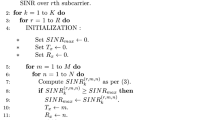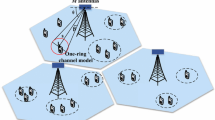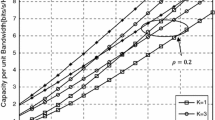Abstract
A combined user and antenna scheduling algorithm implementing spatial multiplexing with limited feedback is proposed for multiple-input multiple-output orthogonal frequency-division multiplexing downlink channel. Base station (BS) should be kept updated about the channel conditions of the different subcarriers of all the users present in the multiple carrier system for the achievement of efficient spectrum utilization. Hence, users convey the channel state information (CSI) in the form of signal-to-interference-plus-noise ratio (SINR) to BS. According to the proposed algorithm, each user sends an array of best SINRs corresponding to each transmit antenna. This scheme overcomes the limitations of the schemes where all the users feed only the maximum CSI to BS. All the antennas at BS are utilized to the fullest by transferring data packets for the entire duration of communication by the proposed algorithm unlike the existing scheduling schemes. The system throughput analysis for this algorithm is presented for both homogeneous and heterogeneous network. Numerical results match well with the simulation results for this two kind of networks.






Similar content being viewed by others
References
Ajibi, W., & Haccoun, D. (2005). An overview of scheduling algorithms in MIMO-based fourth-generation wireless systems. IEEE Network, 19, 43–48.
Bolcskei, H., Gesbert, D., & Paulraj, A. (2002). On the capacity of OFDM based spatial multiplexing systems. IEEE Transactions on Communications, 50, 225–234.
Chiaraviglio, L., Amorosi, L., Cartolano, S., Blefari-Melazzi, N., Dellolmo, P., Shojafar, M., & Salsano, S. (2017). Optimal superfluid management of 5G networks. In IEEE conference on network softwarization (NetSoft) (pp. 1–9).
Choi, L.-U., & Murch, R. D. (2004). A transmit pre-processing technique for multi-user MIMO systems using a decomposition approach. IEEE Transactions on Wireless Communications, 3, 20–24.
Chung, J., Hwang, C. S., Kim, K., & Kim, Y. K. (2003). A random beamforming techniques in MIMO systems exploiting multiuser diversity. IEEE Journal on Selected Areas Communications, 21, 848–855.
David, H. A. (1981). Order statistics (2nd ed.). New York: Wiley.
Dimic, G., & Sidiropoulos, N. D. (2005). On downlink beamforming with greedy user selection: Performance analysis and a simple new algorithm. IEEE Transactions on Signal processing, 53, 3857–3868.
Eslami, M., & Krzymien, W. A. (2011). Net throughput maximization of per-chunk user scheduling for MIMO–OFDM downlink. IEEE Transactions on Vehicular Technology, 60, 4338–4348.
Fakhereddin, M. J., Sharif, M., & Hassibi, B. (2009). Reduced feedback and random beamforming for OFDM MIMO broadcast channels. IEEE Transactions on Communications, 57, 3827–3835.
Kim, C., Ko, K., Jung, S., & Lee, J. (2010). On the SINR distribution for an orthogonal random beamforming system and its performance. In Proceedings on IEEE vehicular technology conference.
McKay, M. R., Smith, P. J., Suraweera, H. A., & Collings, I. B. (2008). On the mutual information distribution of OFDM-based spatial multiplexing: Exact variance and outage approximation. IEEE Transactions on Information Theory, 54, 3260–3278.
Min, M., Kim, D., Kim, H., & Im, G. H. (2013). Opportunistic two-stage feedback and scheduling for MIMO downlink systems. IEEE Transactions on Communications, 61, 312–324.
Muller-Weinfurtner, S. H. (2002). Coding approaches for multiple antenna transmission in fast fading and OFDM. IEEE Transactions on Signal Processing, 50, 2442–2450.
Pattanayak, P., & Kumar, P. (2015). Limited feedback scheduling for MIMO–OFDM broadcast network. In IEEE symposium on wireless personal multimedia communications (WPMC).
Pattanayak, P., & Kumar, P. (2016). SINR based limited feedback scheduling for MIMO–OFDM heterogeneous broadcast networks. In IEEE national conference on communication (NCC) (pp. 1–6).
Pattanayak, P., Pandey, D., & Kumar, P. (2015). Error rate performance for multiuser scheduling in MIMO downlink system with imperfect CSI. In IEEE national conference on wireless communications, vehicular technology, information theory and aerospace and electronic systems (WVITAE).
Pattanayak, P., Trivedi, V. K., Chakraborty, S., & Kumar, P. (2017). BER performance of multi user scheduling for MIMO–STBC and MIMO–OFDM broadcast network with imperfect CSI. In IEEE national conference on signal processing and integrated networks (SPIN) (pp. 66–70).
Pattanayak, P., & Kumar, P. (2015). A computationally efficient genetic algorithm for MIMO broadcast scheduling. Elsevier Applied Soft Computing, 37, 545–553.
Pattanayak, P., & Kumar, P. (2016). Quantized feedback MIMO scheduling for heterogeneous broadcast networks. Wireless Networks Springer, 23, 1–18.
Pattanayak, P., & Kumar, P. (2017). Quantized feedback scheduling for MIMO–OFDM broadcast networks with subcarrier clustering. Elsevier Ad Hoc Networks, 65, 26–37.
Pattanayak, P., Roy, K. M., & Kumar, P. (2015). Analysis of a new MIMO broadcast channel limited feedback scheduling algorithm with user grouping. Springer Wireless Personal Communications, 80, 1079–1094.
Peng, Y., Armour, S. M. D., & McGeeham, J. P. (2007). An investigation of dynamic subcarrier allocation in MIMO–OFDMA systems. IEEE Transactions on Vehicular Technology, 56, 2990–3005.
Sharif, M., & Hassibi, B. (2005). On the capacity of MIMO broadcast channels with partial side information. IEEE Transactions on Information Theory, 51, 506–522.
Soleimani, H., Tomasin, S., Alizadeh, T., & Shojafar, M. (2017). Cluster-head based feedback for simplified time reversal prefiltering in ultra-wideband systems. Elsevier Physical Communication, 25, 100–109.
Stuber, G. L., Barry, J. R., McLaughlin, S. W., Li, Y. G., Ingram, M. A., & Pratt, T. G. (2004). Broadband MIMO–OFDM wireless communications. Proceedings of the IEEE, 92, 271–294.
Svedman, P., Wilson, S. K., Cimini, L. J., & Ottersten, B. (2007). Opportunistic beamforming and scheduling for OFDMA systems. IEEE Transactions on Communications, 55, 941–952.
Swannack, C., Uysal-Biyikoglu, E., & Wornell, G. W. (2005). MIMO broadcast scheduling with limited channel state information. Proceedings of Annual Allerton Conference on Communications, Control and Computing.
Viswanath, P., Tse, D. N. C., & Laroia, R. (2002). Opportunistic beamforming using dumb antennas. IEEE Transactions on Information Theory, 48, 1277–1294.
Wong, C. Y., Cheng, R. S., Lataief, K. B., & Murch, R. D. (1999). Multiuser ofdm with adaptive subcarrier, bit and power allocation. IEEE Journal on Selected Areas in Communications, 17, 1747–1758.
Yoo, T., & Goldsmith, A. (2006). On the optimality of multiantenna broadcast scheduling using zero-forcing beamforming. IEEE Journal on Selected Areas in Communications, 24, 528–541.
Zhang, W., & Letaief, K. B. (2007). MIMO broadcast scheduling with limited feedback. IEEE Journal on Selected Areas in Communications, 25, 1457–1467.
Author information
Authors and Affiliations
Corresponding author
Ethics declarations
Conflict of interest
On behalf of all authors, the corresponding author states that there is no conflict of interest.
Rights and permissions
About this article
Cite this article
Pattanayak, P., Kumar, P. Combined user and antenna scheduling scheme for MIMO–OFDM networks. Telecommun Syst 70, 3–12 (2019). https://doi.org/10.1007/s11235-018-0462-0
Published:
Issue Date:
DOI: https://doi.org/10.1007/s11235-018-0462-0




